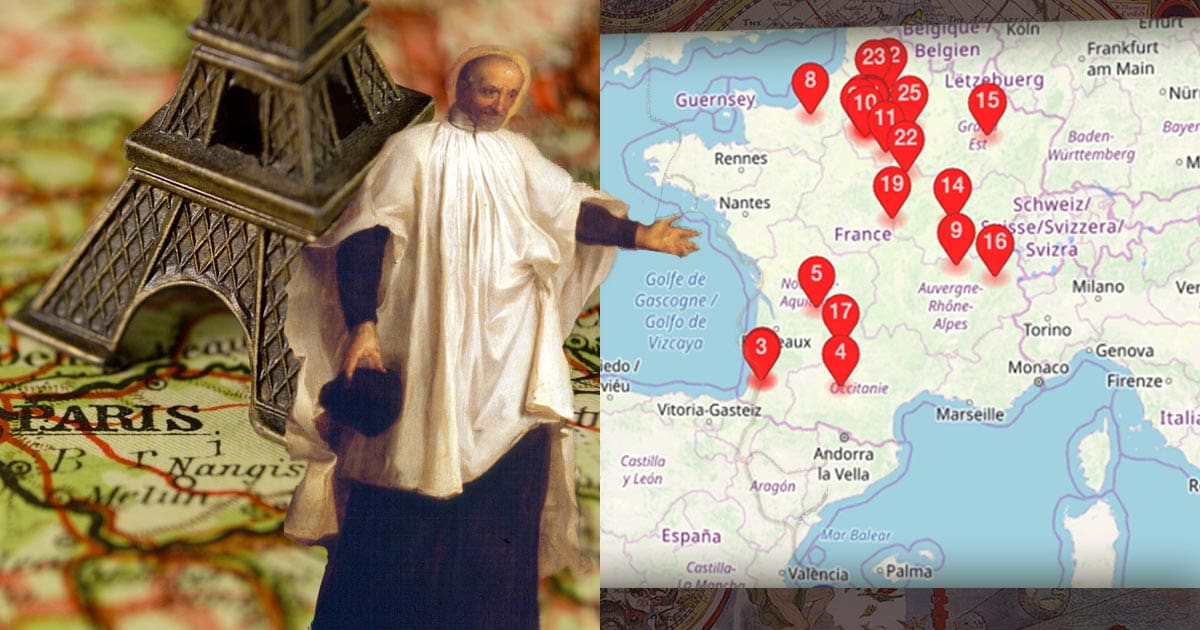Vincentian Places 05 – Château-l’Évêque
Part of a Series on Vincentian Heritage Places
Château-l’Évêque
Use mouse wheel to zoom
Vincent de Paul was ordained a priest on September 23, 1600, in a chapel at Château-l’Évêque, a village in the south of France. There is a certain amount of controversy surrounding this date, as it would mean he was only 19 years of age at the time, making him below the required canonical age for priesthood ordination. It seems the reforms of the Council of Trent had not yet reached this corner of France. Further discussion centres around the reasons for Vincent going to Château-l’Évêque, in the hills of the Dordogne, and some distance from Toulouse where he was then residing, for his ordination.

The picture above shows an aerial view of the village of Château-l’Évêque. The picture below shows the interior of the Chapel where Vincent was ordained. A plaque on the left wall commemorates his ordination. This Chapel now forms part of the transept in the present-day Church.

Chapel where Vincent was ordained
As its name indicates, the town of Château-l’Évêque is named after the fortress and the residence of the bishops of Périgueux, ten kilometers to the south. It has borne this name officially, however, only since 1831. The bishops used this fort-residence from the fourteenth century to the Revolution. Its importance came from its location at a significant point in the Beauronne valley water system. The chateau underwent major repairs in the fifteenth and sixteenth centuries. In the sixteenth century, Protestant (Huguenot) forces often attacked it. In fact they succeeded in assassinating the bishop of Périgueux in 1575. Now in private hands, its recent owners have named the castle Château Saint Vincent.
Next to the chateau is the parish church of Saint Julian. Since the name Julian, a patron of sick travelers, was often attached to hospices for travelers, it can be presumed that this chapel was originally used for pilgrims and travelers. It has since been incorporated as a side chapel in the small parish church. It keeps its original orientation, facing away from the present main altar.
Thanks to the efforts of Father Jean Baptiste Etienne, the parish church was restored beginning in 1874. A plaque recalls Vincent’s ordination there, as do copies in Latin and French of his ordination document.
The remains of the early chapel consist principally of the two pilasters at the edge of the sanctuary (the three double Gothic columns are nineteenth century) and the stones in the floor of the sanctuary. Above the sanctuary was an attic, an area now demolished. It was there among old papers that a copy of the saint’s ordination record was found in the nineteenth century.
Château-l’Évêque is a small village of 1,800 persons. The Daughters of Charity run a retirement home here (begun in 1869) and receive guests as lodgers for retreats, etc. Some Vincentians lived here from 1877 to 1883 and returned later as chaplains to the Sisters. During the Second World War, the body of Saint Vincent was hidden in their chapel (from 20 May 1940 to 3 June 1945). As the Nazis made some advances in 1942, the body was temporarily removed from there to a woodshed for fear of discovery.
At the south edge of town is a road leading to Périgueux said to have been laid out in the time of the ancient Romans (Voie Romaine). To the left, before this road begins, are signs for the Calvaire, a modern series of Stations of the Cross leading up the hillside.
Many years later Vincent reflected on his priesthood: “As for myself, if I had known what it was when I had the temerity to enter it– as I have come to know since then– I would have preferred to till the soil than to commit myself to such a formidable state of life. I have said this more than a hundred times to poor country people when, to encourage them to live contentedly as upright persons, I told them I considered them fortunate in their situation. Indeed, the older I get, the more convinced I am of this because day by day I discover how far removed I am from the state of perfection in which I should be living.” (letter 2027)
Source: VincentWiki
More photos of this place, here
All Vincentian Places in this Series
Use mouse wheel to zoom










0 Comments